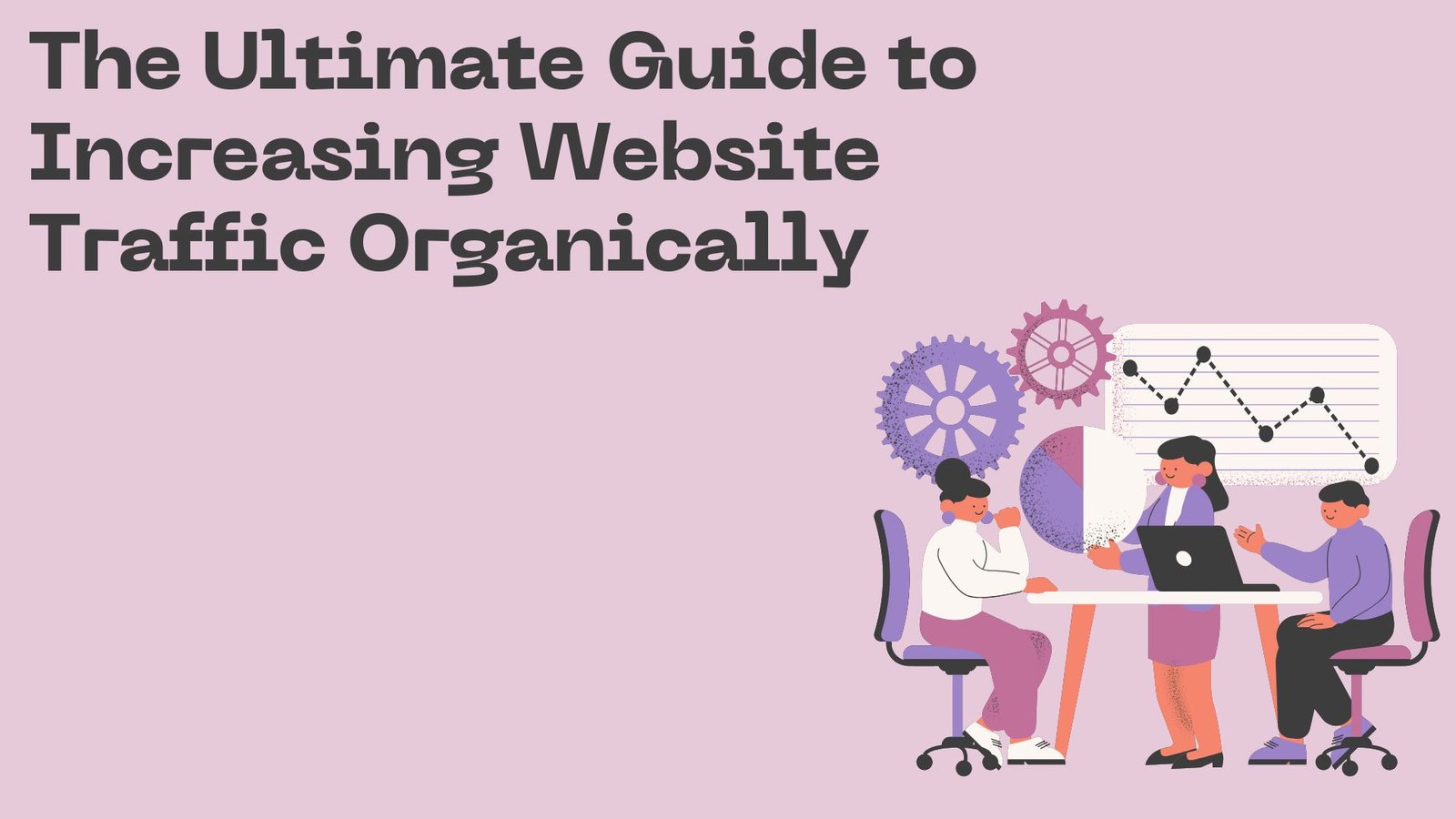Increasing website traffic is a crucial goal for any business looking to expand its online presence. While there are many ways to drive traffic, organic methods tend to be the most sustainable and cost-effective. This guide will cover everything you need to know about boosting your website traffic organically, providing practical tips that you can start using today.
What Is Organic Traffic?
Organic traffic refers to visitors that come to your website through unpaid search results. These visitors find your website on search engines like Google, Bing, or Yahoo. Unlike paid ads, organic traffic is free, and the results tend to be more long-lasting. Investing in strategies that boost organic traffic can build a steady stream of visitors over time, helping you grow your audience naturally.
Why Focus on Organic Traffic?
Focusing on organic traffic offers several benefits:
- Cost-Effective: Organic traffic doesn’t require you to spend on advertisements. Once you have optimized your website, you can continue to attract visitors without additional costs.
- Higher Trust: Users tend to trust organic search results more than ads. Ranking well organically builds credibility.
- Sustainable Growth: Unlike paid campaigns, which require ongoing investment, organic traffic tends to have a longer lifespan.
Now, let’s explore how you can increase your website traffic through various organic strategies.
Mastering the Basics of SEO
Search Engine Optimization (SEO) is the foundation of organic traffic. It helps search engines understand what your content is about, so they can show it to the right users. Here’s how you can master the basics of SEO:
Conduct Keyword Research
Keyword research is the process of identifying terms that users search for related to your business. Use tools like Google Keyword Planner, Ahrefs, or Ubersuggest to find relevant keywords. Aim for a mix of short-tail (one or two words) and long-tail (three or more words) keywords for better reach.
Optimize On-Page Elements
Your website’s on-page elements, like meta titles, meta descriptions, headers, and URL structure, play a critical role in ranking higher. Ensure that your target keywords appear naturally in these areas without overstuffing.
Create High-Quality Content
Content is king when it comes to SEO. Write articles, blogs, and guides that provide value to your audience. Focus on answering common questions in your industry and providing in-depth information. Google rewards content that is informative, well-structured, and easy to read.
Building a User-Friendly Website
A website that is easy to navigate and loads quickly can significantly impact your search engine rankings. Let’s look at some essential tips:
Improve Website Speed
A fast-loading website is crucial for keeping users engaged. Google’s algorithm considers page speed when ranking websites. Use tools like Google PageSpeed Insights to identify speed-related issues and fix them.
Make Your Website Mobile-Friendly
With more people browsing the web on mobile devices, having a responsive design is essential. Make sure your website adjusts to different screen sizes to provide a seamless user experience across all devices.
Enhance User Experience (UX)
A website that is easy to navigate keeps users on the page longer, reducing your bounce rate. Use simple navigation menus, clear CTAs (call-to-actions), and a clean layout to enhance the user experience.
Leverage Content Marketing for Organic Growth
Content marketing can help you attract new visitors to your website by providing valuable information. Here are some ways to use content marketing for organic growth:
Start a Blog
Blogging is an excellent way to attract organic traffic. Write about topics related to your industry, offering tips, insights, and news updates. A well-maintained blog can boost your website authority and increase visibility in search engines.
Use Video Content
Video content is increasingly popular among users. Platforms like YouTube can help drive organic traffic back to your website. Create videos that answer common questions or demonstrate how to use your products or services, and include links to your website in the video description.
Optimize for Featured Snippets
Featured snippets are short answers that appear at the top of Google search results. To optimize for these, structure your content in a way that directly answers questions. Use bullet points, numbered lists, and short paragraphs to improve your chances of being featured.
Strengthening Your Off-Page SEO
Off-page SEO includes activities outside of your website that can help improve your search rankings. Let’s discuss some effective strategies:
Build High-Quality Backlinks
Backlinks from authoritative websites signal to search engines that your site is trustworthy. Reach out to other websites for guest blogging opportunities or create shareable infographics that others might link to. The more high-quality backlinks you have, the better your chances of ranking higher.
Engage on Social Media
Social media platforms like Facebook, Instagram, and LinkedIn can drive traffic to your website. Share your blog posts and other content on social media to attract a broader audience. Though social media links are not direct ranking factors, they can bring more visitors to your site, indirectly boosting your SEO.
Participate in Online Communities
Engage in forums and Q&A sites like Reddit and Quora, where people ask questions related to your niche. Provide helpful answers and include links to your website when relevant. This can drive targeted traffic back to your website.
Analyzing and Improving Your SEO Efforts
SEO is not a one-time task; it requires regular monitoring and adjustments. Here’s how you can stay on top of your SEO game:
Use Analytics Tools
Tools like Google Analytics and Google Search Console provide insights into how users find your website and what they do once they get there. Monitor metrics like organic traffic, bounce rate, session duration, and conversion rates to see what is working.
Conduct Regular SEO Audits
Performing an SEO audit helps you identify issues that might be holding your website back. Check for broken links, duplicate content, and slow-loading pages. Addressing these issues can improve your website’s performance.
Stay Updated with SEO Trends
SEO is always evolving, with Google constantly updating its algorithms. Follow SEO blogs, attend webinars, and participate in online courses to keep up with the latest best practices.
Local SEO for Attracting Nearby Customers
If you run a local business, focusing on local SEO can help you attract nearby customers. Here’s how:
Optimize Your Google My Business Listing
Create and optimize a Google My Business (GMB) listing for your business. Ensure that your name, address, and phone number are consistent across all online directories. A well-maintained GMB profile can help you appear in local searches and on Google Maps.
Get Customer Reviews
Encourage your customers to leave reviews on your GMB listing and other review platforms like Yelp. Positive reviews can enhance your credibility and help you rank better in local search results.
Use Local Keywords
Incorporate local keywords into your content, such as the name of your city or neighborhood. This can help your website show up when users search for businesses in your area.
The Role of Content Refreshing
Refreshing your old content can give it a new lease on life. Here’s how to do it:
Update Old Blog Posts
Update outdated information in your old blog posts. Add new statistics, images, and internal links. Google favors content that is up-to-date and relevant.
Add New Keywords
As new keywords gain popularity, add them to your old content. This can help your content attract a fresh audience.
Repurpose Content
Repurpose existing blog posts into different formats like infographics, podcasts, or videos. This helps you reach a wider audience and boosts your website’s visibility
Conclusion
Increasing your website traffic organically requires a blend of SEO, content creation, and regular analysis. By focusing on providing value to your audience, optimizing your website for search engines, and engaging with your community, you can build a sustainable stream of visitors. While this approach takes time, the long-term benefits are worth the investment. To further enhance your results, consider seeking support from an organic SEO services provider, which can guide you through the process and help maximize your website’s potential.
With consistent efforts and a strategic approach, you can see a significant increase in organic traffic to your website.
FAQs
Q1: How long does it take to see results from organic SEO efforts?
Organic SEO is a long-term strategy, and it usually takes around 3 to 6 months to start seeing noticeable results. However, the exact timeline can vary depending on factors like keyword competition, website age, and the quality of content. Patience is key when working on organic growth.
Q2: What are the best types of content for increasing organic traffic?
Blog posts, guides, and how-to articles are excellent for increasing organic traffic. Other effective types include video content, infographics, and listicles. The key is to create content that is valuable and answers the questions your target audience is searching for.
Q3: Can I improve my website’s organic traffic without technical SEO knowledge?
Yes, you can improve your website’s organic traffic by focusing on content creation, keyword research, and user engagement. While technical SEO can help with site speed and structure, many aspects, like writing quality content and engaging with users, do not require technical expertise.












Leave a Reply